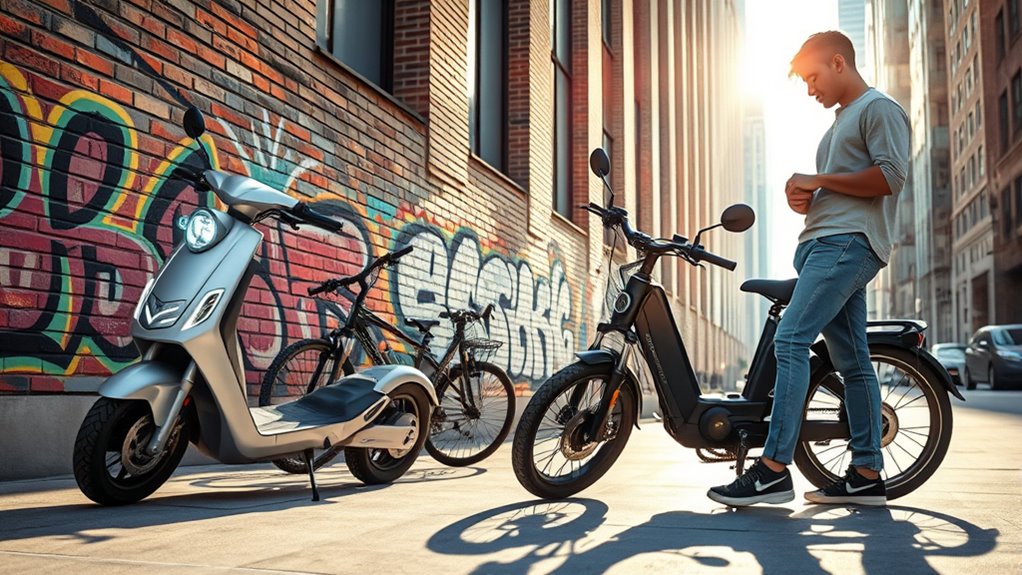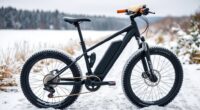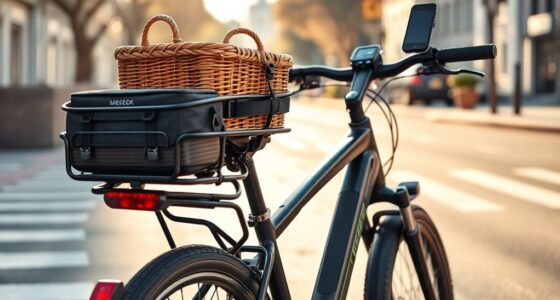If you want something lightweight, portable, and perfect for quick urban trips, an e-scooter might suit your lifestyle. It’s easy to fold, maneuver tight spaces, and ride for short distances with decent speed. But if you prefer comfort for longer rides, higher speeds, and tackling varied terrains, an e-bike could be a better fit. To find out which option matches your needs and lifestyle better, keep exploring the details ahead.
Key Takeaways
- Choose an e-scooter for quick, short urban trips, and easy portability in crowded areas.
- Opt for an e-bike if you prefer longer rides, higher speeds, and off-road capability.
- Consider comfort needs: e-bikes offer seated rides for extended travel, while e-scooters suit quick stand-up commutes.
- Evaluate maintenance and cost: e-scooters are cheaper initially but may require more frequent replacements; e-bikes have higher upfront costs but longer battery life.
- Check local regulations and parking options to ensure safe, legal, and convenient use matching your lifestyle.
Comparing Design and Portability

When comparing design and portability, you’ll notice that e-scooters are typically more compact and lightweight, making them easier to carry and store. Many models feature a foldable design, allowing you to quickly collapse the scooter into a smaller size. This foldable design enhances portability, so you can carry it onto public transit or tuck it into a closet without hassle. E-scooters are ideal for those who need convenience and space-saving options, especially in crowded urban areas. Their compact storage means you don’t need a dedicated garage or large space to keep them. In contrast, e-bikes tend to be larger and less maneuverable when folded. Overall, if portability and easy storage are priorities, e-scooters offer a clear advantage. Additionally, mobility solutions like e-scooters are designed with urban commuting in mind, emphasizing ease of transport and quick deployment.
Performance and Speed Capabilities
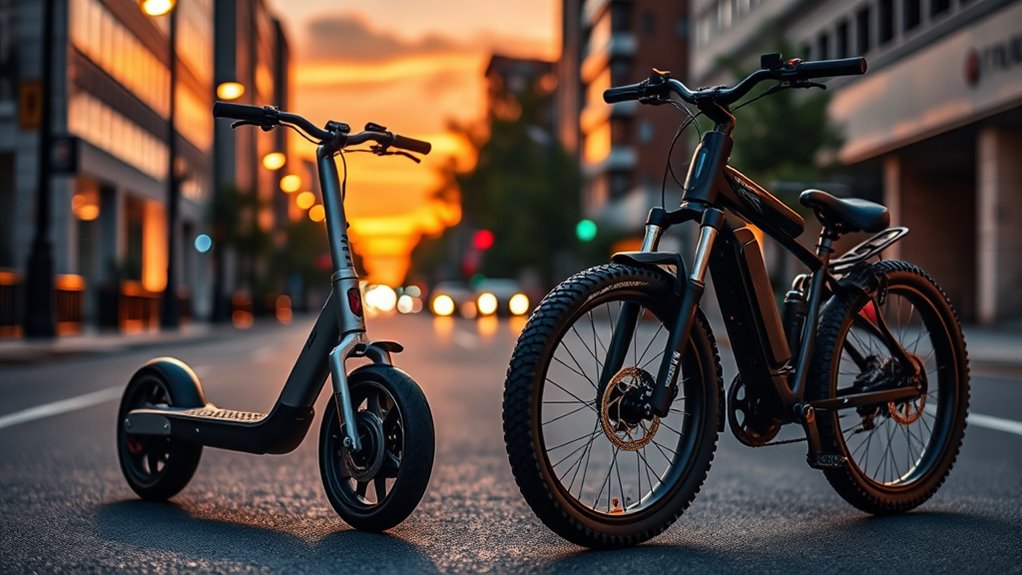
When it comes to performance, your choice depends on how fast and powerful you need your ride to be. E‑scooters typically have lower speed limits but offer quick acceleration, while e‑bikes can reach higher top speeds with more power. Consider your daily needs and how these differences impact your riding experience. For those interested in customizing their rides, understanding GMC tuning principles can provide insights into optimizing performance and tailoring vehicles to specific preferences.
Speed Limits and Power
Ever wonder how e-scooters and e-bikes compare regarding speed and power? They’re regulated differently depending on your location, with specific speed regulations and power restrictions. E-scooters often have a top speed of around 15-20 mph due to local limits, and their power is usually capped at 500W. E-bikes, on the other hand, can reach higher speeds, often up to 28 mph, with some models exceeding that, depending on local laws. Detect passive voice To improve clarity, active voice can be used in descriptions of regulations and features. Consider these factors: – Speed regulations vary by city and state – Power restrictions keep e-scooters safe and legal – E-bikes may have higher wattage limits – Speed limits influence riding style and safety – Power restrictions impact performance and range
Acceleration and Top Speed
E-scooters typically accelerate quickly from a standstill, reaching their top speeds within a few seconds, which makes them ideal for maneuvering urban environments efficiently. Their motor acceleration is designed for quick responses, helping you navigate crowded streets smoothly. The top speed of an e-scooter usually hits around 15-20 mph, limited by speed thresholds to ensure safety. E-bikes, on the other hand, often have more gradual acceleration but higher top speeds, often exceeding 25 mph with pedal assist or throttle. Here’s a quick comparison:
| Feature | E-Scooter | E-Bike |
|---|---|---|
| Acceleration | Fast, within seconds | Moderate, steady |
| Top Speed | 15-20 mph | 25+ mph |
| Motor Power & Threshold | Lower, restricted by law | Higher, more powerful |
Additionally, the performance capabilities of each vehicle type are influenced by their motor power and design, affecting how quickly they respond and how fast they can go.
Range and Battery Life Considerations
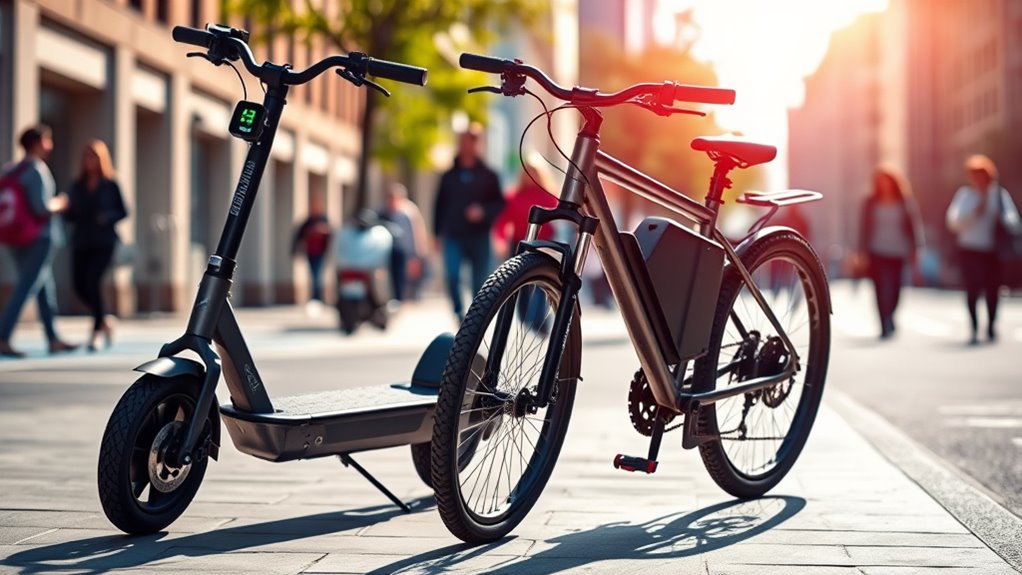
Battery life and range are key factors to contemplate when choosing between an e-scooter and an e-bike. Your decision depends on how far you need to travel and how often you’ll recharge. E-bikes typically offer longer ranges due to larger batteries, but charging times can be slower. E-scooters often have quicker charging cycles, making them convenient for short trips or daily commutes. Keep in mind:
- Battery longevity impacts overall lifespan and performance
- Longer ranges mean fewer stops for recharging
- Charging times vary between models, affecting convenience
- Battery capacity influences how far you can go on a single charge
- Regular maintenance extends battery life and efficiency
- Kia Tuning options for electric vehicles can enhance battery performance and longevity
Understanding these factors helps you determine which vehicle aligns with your travel needs and lifestyle.
Comfort and Riding Experience
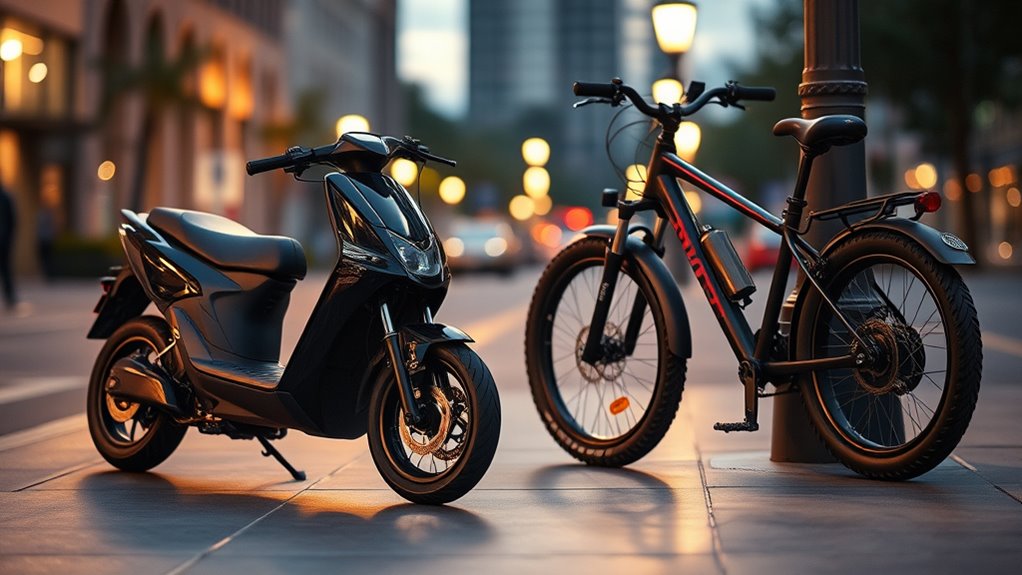
While both e-scooters and e-bikes aim to offer convenient urban transportation, they differ markedly in comfort and riding experience. E-bikes typically feature ergonomic seating, allowing you to sit comfortably for longer rides and maintain a relaxed riding posture. This can reduce fatigue and provide a smoother experience, especially on uneven surfaces. E-scooters, on the other hand, require you to stand while riding, which can be less comfortable over extended periods and may lead to fatigue or strain. However, their compact design often offers agility and quick maneuverability. Your comfort depends on your preferences—if you prioritize relaxed seating and a natural riding posture, an e-bike might suit you better. Conversely, if you prefer standing, quick rides, and easy portability, an e-scooter offers a different riding experience. Additionally, considering your riding comfort preferences can help you choose the best option for your lifestyle.
Cost and Maintenance Factors
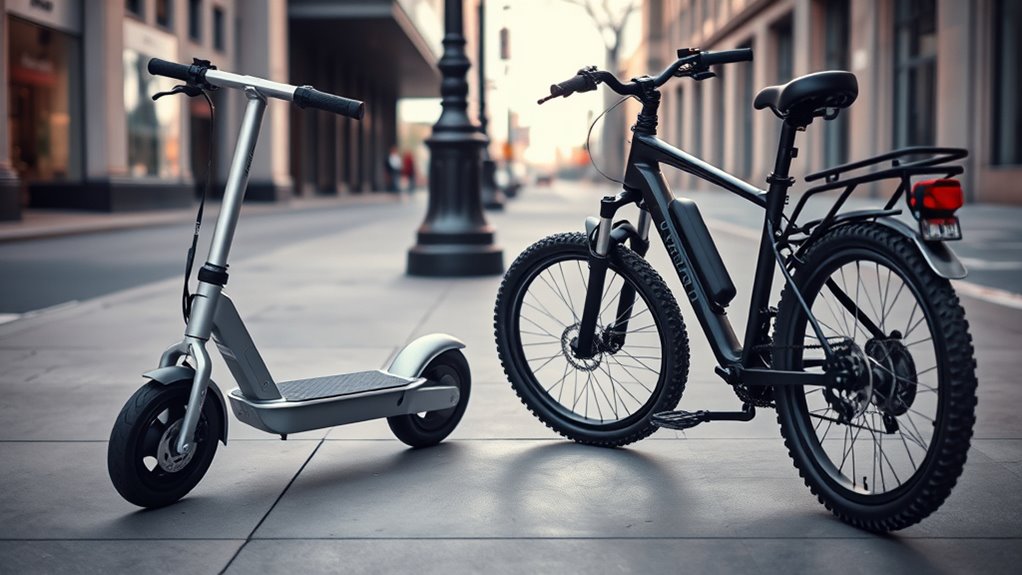
When considering the overall riding experience, cost and maintenance are important factors that can influence your choice between an e-scooter and an e-bike. E-scooters generally have lower upfront costs but might require more frequent battery replacements due to shorter battery lifespan. E-bikes tend to be pricier initially but often have longer-lasting batteries, reducing replacement costs. Maintenance needs vary; e-scooters need regular checks on tires and brakes, while e-bikes require more extensive upkeep of gears and chains. Theft prevention is also vital—e-bikes can be more expensive and attractive targets, so investing in good locks or GPS trackers is wise. Keep in mind:
- Battery replacement costs
- Frequency of maintenance
- Theft prevention measures
- Initial purchase price
- Long-term durability
- Proper use and care can extend the lifespan of both types of vehicles and reduce overall costs.
Safety Features and Risks
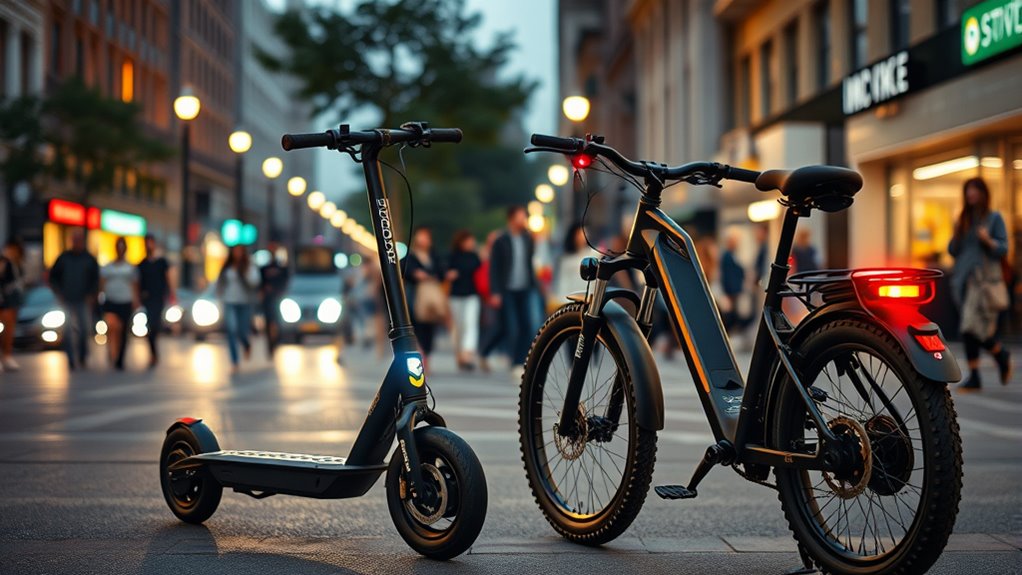
Safety features and risks play a essential role in choosing between an e-scooter and an e-bike. Helmet safety is critical for both, as head injuries can be severe in accidents. Many riders overlook wearing a helmet, but it markedly reduces injury risk. Rider visibility is equally important; bright lights and reflective gear help you stay seen by others, especially at night or in poor weather conditions. E-bikes often have more built-in safety features, like larger lights and mirrors, while e-scooters may rely more on rider awareness. Both vehicles carry risks, such as falls or collisions, but understanding safety gear and staying alert can help mitigate these dangers. Prioritizing safety features guarantees you enjoy your ride while minimizing potential harm. Incorporating public safety awareness into your riding habits can further reduce the risk of accidents and promote responsible riding.
Ideal Use Scenarios and Terrain Handling
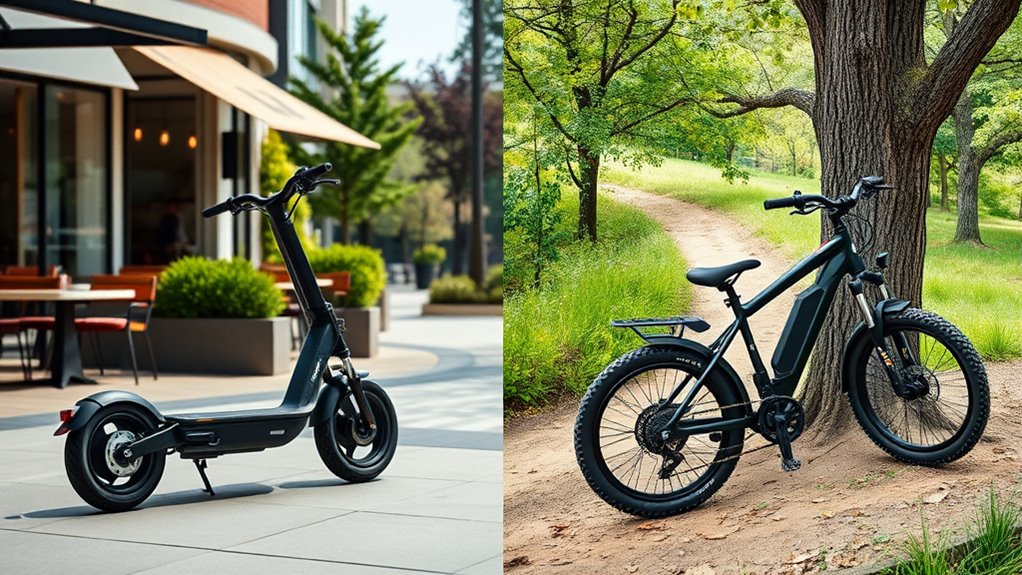
Your choice between an e-scooter and an e-bike depends largely on where and how you plan to ride. If you mostly navigate urban commutes or quick trips, an e-scooter offers convenience and agility. For rugged terrains or leisurely rides on smooth pavements, an e-bike provides the stability and power you need. Additionally, consider the power capacity of each option to ensure it meets your endurance requirements.
Urban Commutes and Short Trips
E-scooters and e-bikes excel in urban environments where quick, nimble transportation is essential. They help you navigate crowded streets and tight spaces with ease. Their compact size makes them ideal for short trips and daily commutes, reducing your reliance on cars and easing traffic congestion. Both options fit seamlessly into urban planning strategies focused on sustainable mobility. Here are some benefits:
- Easily weave through congested traffic
- Perfect for last-mile connectivity
- Store conveniently in small spaces
- Save time on short routes
- Reduce your carbon footprint
Whether you prefer the quick acceleration of an e-scooter or the stability of an e-bike, both are designed to fit your fast-paced city lifestyle. They make urban commuting efficient, eco-friendly, and stress-free.
Rugged Terrain and Off-Roading
While both e-scooters and e-bikes are popular choices for urban travel, their capabilities differ markedly when it comes to rugged terrain and off-roading. E-bikes are better suited for mountain trails and mud riding, thanks to their sturdy frames, larger tires, and powerful motors. They handle uneven surfaces and steep inclines with ease, giving you confidence on challenging paths. E-scooters, however, are generally limited to smoother surfaces and struggle on rough terrain due to their smaller wheels and less robust build. If you’re seeking adventure beyond city streets, an e-bike offers the versatility to explore dirt trails and muddy tracks. E-scooters are simply not designed for the demands of off-road riding, making e-bikes your smarter choice for rugged terrain.
Smooth Pavements and Leisure Rides
When it comes to smooth pavements and leisurely rides, both e-scooters and e-bikes excel, but each offers distinct advantages suited to relaxed cruising. E-scooters often feature compact designs with lighter weight, making them easy to carry and park, perfect for short, casual trips. E-bikes typically have larger tires and more comfortable seating, ideal for longer, relaxed rides. Battery options vary, with e-bikes offering larger capacity batteries for extended rides, while e-scooters focus on portability. Tire types also differ: e-scooters usually have smooth, narrow tires for speed, whereas e-bikes sport wider, more cushioned tires for stability. Consider your terrain and ride length to choose the best fit for your leisure adventures. Additionally, the home decoration theme can be incorporated into your riding experience by choosing stylish storage solutions for your e-scooter or e-bike when not in use. Both options deliver smooth rides, but your preferences will guide the right choice.
Environmental Impact and Sustainability
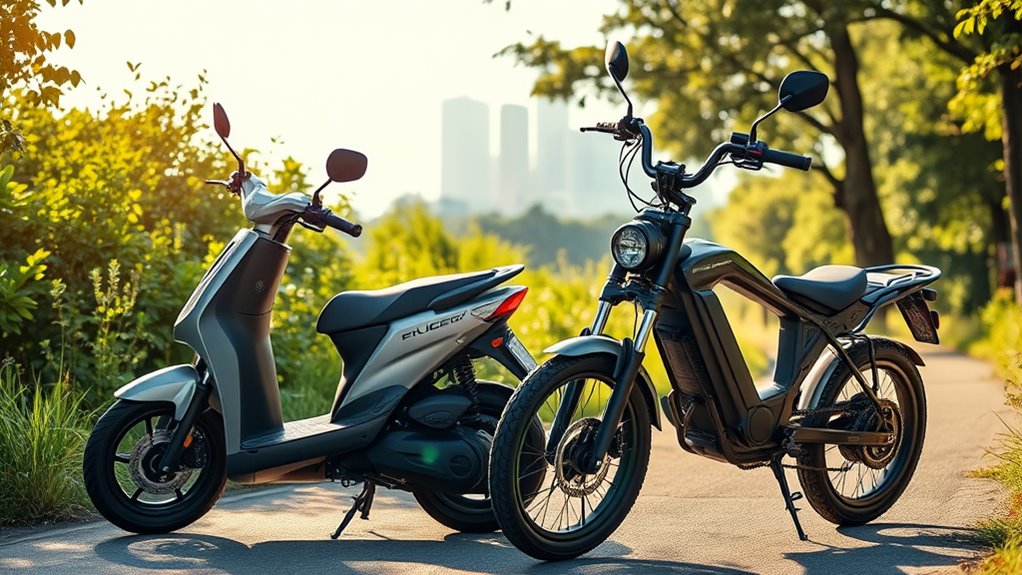
Both e-scooters and e-bikes offer environmentally friendly transportation options, but their sustainability impacts vary considerably. E-bikes generally have a lower environmental footprint because they require more durable materials and longer-lasting batteries, reducing waste over time. E-scooters often rely on frequent replacements, but many companies are adopting recycling initiatives to reuse batteries and components, minimizing landfill waste. Both vehicles can benefit from renewable energy sources like solar or wind power, which further reduces their carbon footprint. By choosing models with eco-conscious manufacturing and supporting initiatives that promote recycling, you can enhance sustainability. Additionally, the battery lifespan of these vehicles plays a crucial role in their overall environmental impact, as longer-lasting batteries reduce the need for frequent replacements. Ultimately, your choice depends on how you prioritize longevity, recyclability, and the use of renewable energy, making both options more environmentally friendly than traditional transportation.
Legal Regulations and Parking Rules
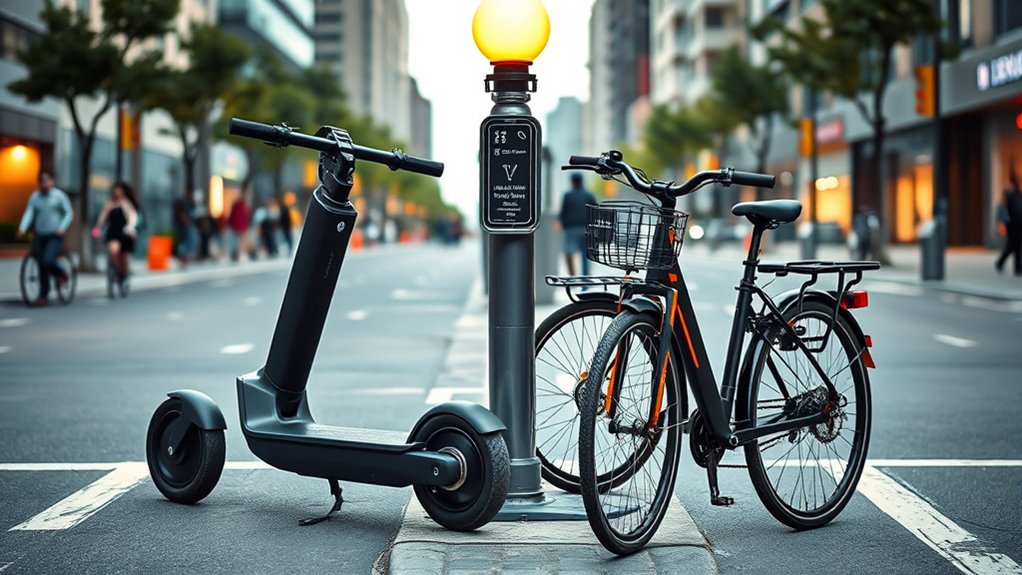
Understanding legal regulations and parking rules for e-scooters and e-bikes can be complex, as authorities set different standards depending on your location. Grasping legal classifications helps determine where you can ride and park. For instance, some cities require scooters to stay on bike lanes, while others allow sidewalk use. Parking regulations may restrict you from leaving your e-scooter or e-bike in certain areas, like bus stops or crosswalks. To stay compliant, keep these points in mind:
- Check local laws for legal classifications
- Use designated parking zones
- Avoid blocking pedestrian pathways
- Follow speed limits set by authorities
- Respect signage and restricted areas
- Familiarize yourself with bank SWIFT/BIC codes to ensure secure financial transactions when renting or purchasing e-scooter services.
Staying informed about these rules ensures you ride responsibly and avoid fines.
Frequently Asked Questions
Which Option Is Better for Daily Commuting?
For daily commuting, you should consider how urban mobility suits your routine and the environmental impact. E‑bikes are better if you need to cover longer distances or tackle hilly terrain, offering comfort and efficiency. E‑scooters work well for short trips and quick errands, providing flexible urban mobility. Both options reduce your carbon footprint, but your choice depends on your daily distance, terrain, and convenience needs.
Can E-Scooters and E-Bikes Be Used Together?
You can absolutely use e-scooters and e-bikes together, and it’s like hitting two birds with one stone. They often share charging stations and storage solutions, making changes smooth and convenient. Many commuters carry both, switching between them based on distance or terrain. Just make certain your storage options are flexible, and check if shared charging stations are available along your route. This combo keeps your travel options open and efficient.
How Do Insurance Requirements Differ for Each Vehicle?
When considering insurance coverage, e-scooters and e-bikes have different liability requirements. You’ll often find that e-scooters require minimal insurance, sometimes just personal liability, especially if used in ride-share programs. E-bikes, on the other hand, may need more all-encompassing coverage, including property damage and personal injury, depending on local regulations. Always check your state’s laws to verify you meet liability requirements and have suitable insurance for each vehicle.
Are There Age Restrictions for Riding E-Scooters or E-Bikes?
Age restrictions and licensing requirements vary depending on where you ride, but generally, you need to be at least 16 years old to operate e-scooters and e-bikes. Some places may require a license or permit, especially for e-bikes with higher speeds or power. Always check local regulations, as these can differ, ensuring you’re compliant and safe while riding.
What Accessories Enhance Safety and Convenience?
To enhance safety and convenience, you should prioritize helmet safety and storage solutions. Wearing a helmet reduces injury risk during rides, while secure storage options help you carry essentials without hassle. Consider adding reflective accessories for visibility, especially at night. These upgrades make your rides safer and more practical, ensuring you stay protected and organized whether you’re commuting or exploring.
Conclusion
Ultimately, choosing between an e-scooter and an e-bike is like picking your own adventure—each offers a unique path through city streets and scenic routes. Think of the e-scooter as a swift breeze, ideal for quick errands, while the e-bike resembles a steady stream, perfect for longer journeys. Whichever you choose, let it be your trusted vessel in steering through urban jungles and open roads alike, turning everyday commutes into your personal voyage.
